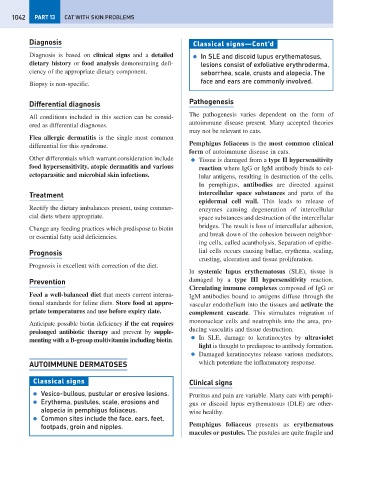Page 1050 - Problem-Based Feline Medicine
P. 1050
1042 PART 13 CAT WITH SKIN PROBLEMS
Diagnosis Classical signs—Cont’d
Diagnosis is based on clinical signs and a detailed ● In SLE and discoid lupus erythematosus,
dietary history or food analysis demonstrating defi- lesions consist of exfoliative erythroderma,
ciency of the appropriate dietary component. seborrhea, scale, crusts and alopecia. The
face and ears are commonly involved.
Biopsy is non-specific.
Differential diagnosis Pathogenesis
All conditions included in this section can be consid- The pathogenesis varies dependent on the form of
ered as differential diagnoses. autoimmune disease present. Many accepted theories
may not be relevant to cats.
Flea allergic dermatitis is the single most common
differential for this syndrome. Pemphigus foliaceus is the most common clinical
form of autoimmune disease in cats.
Other differentials which warrant consideration include ● Tissue is damaged from a type II hypersensitivity
food hypersensitivity, atopic dermatitis and various reaction where IgG or IgM antibody binds to cel-
ectoparasitic and microbial skin infections. lular antigens, resulting in destruction of the cells.
In pemphigus, antibodies are directed against
Treatment intercellular space substances and parts of the
epidermal cell wall. This leads to release of
Rectify the dietary imbalances present, using commer- enzymes causing degeneration of intercellular
cial diets where appropriate. space substances and destruction of the intercellular
Change any feeding practices which predispose to biotin bridges. The result is loss of intercellular adhesion,
or essential fatty acid deficiencies. and break down of the cohesion between neighbor-
ing cells, called acantholysis. Separation of epithe-
Prognosis lial cells occurs causing bullae, erythema, scaling,
crusting, ulceration and tissue proliferation.
Prognosis is excellent with correction of the diet.
In systemic lupus erythematosus (SLE), tissue is
Prevention damaged by a type III hypersensitivity reaction.
Circulating immune complexes composed of IgG or
Feed a well-balanced diet that meets current interna- IgM antibodies bound to antigens diffuse through the
tional standards for feline diets. Store food at appro- vascular endothelium into the tissues and activate the
priate temperatures and use before expiry date. complement cascade. This stimulates migration of
Anticipate possible biotin deficiency if the cat requires mononuclear cells and neutrophils into the area, pro-
prolonged antibiotic therapy and prevent by supple- ducing vasculitis and tissue destruction.
menting with a B-group multivitamin including biotin. ● In SLE, damage to keratinocytes by ultraviolet
light is thought to predispose to antibody formation.
● Damaged keratinocytes release various mediators,
AUTOIMMUNE DERMATOSES which potentiate the inflammatory response.
Classical signs Clinical signs
● Vesico-bullous, pustular or erosive lesions. Pruritus and pain are variable. Many cats with pemphi-
● Erythema, pustules, scale, erosions and gus or discoid lupus erythematosus (DLE) are other-
alopecia in pemphigus foliaceus. wise healthy.
● Common sites include the face, ears, feet,
footpads, groin and nipples. Pemphigus foliaceus presents as erythematous
macules or pustules. The pustules are quite fragile and

